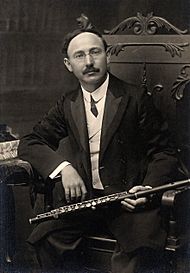Leonardo De Lorenzo facts for kids
Quick facts for kids
Leonardo De Lorenzo
|
|
|---|---|

Leonardo De Lorenzo in 1913
|
|
| Background information | |
| Born | August 29, 1875 Viggiano, Basilicata |
| Died | July 29, 1962 (aged 86) Santa Barbara, California |
| Genres | Classical |
| Occupation(s) | Flutist, professor |
| Instruments | Flute |
Leonardo De Lorenzo (born August 29, 1875 – died July 29, 1962) was a super talented Italian flutist and music teacher. He was known for his amazing flute playing and for teaching others how to play the flute.
Contents
Leonardo De Lorenzo's Life Story
Early Life and Musical Start
Leonardo De Lorenzo was born in a town called Viggiano in Italy. He started playing the flute when he was just 8 years old. Later, he moved to Naples to study music at the "San Pietro a Majella" Music Conservatory.
When he was 16, Leonardo moved to the United States. He worked at a hotel in Cerulean, Kentucky. But in 1896, he went back to Italy for military service. While there, he joined a military band in Alessandria.
Touring and Orchestras
After his military service, Leonardo began his own music career. He traveled and performed in many countries. He toured around Italy, Germany, England, and even South Africa. When he was 25, he joined an orchestra in Cape Town.
In 1907, he returned to Naples to finish his studies. Then, he went back to America. He became the main flutist for the famous New York Philharmonic Orchestra. This orchestra was led by the well-known conductor Gustav Mahler. Leonardo also played with the New York Symphony Orchestra.
He was also a flutist for other big orchestras. These included the Minneapolis Symphony Orchestra, the Los Angeles Philharmonic, and the Rochester Philharmonic Orchestra.
Family and Honors
In 1914, while playing with the Minneapolis Symphony Orchestra, he met Maude Peterson. She was a pianist who often played music with him. They later got married.
In 1917, the Los Angeles Flute Club honored him. They held a special musical event for him. Leonardo De Lorenzo was named the first Honorary Member of their club.
Teaching and Writing
From 1923 to 1935, Leonardo taught flute at the Eastman School of Music. One of his students, Julius Baker, became one of the greatest American flutists of his time.
After he stopped performing and teaching full-time, Leonardo focused on writing music and books. He wrote pieces like Saltarello and Pizzica-pizzica. These songs were inspired by the traditional music of his hometown.
In 1951, he published a very important book called My complete story of the flute. This book was the result of a lot of research. It made him one of the most important flute teachers of the 20th century.
Later Life and Legacy
On October 25, 1953, Leonardo donated all his research materials to the University of Southern California. In the same year, he received an honorary doctorate degree from an academy in Rome. He also helped start a new flute club in Milan.
On August 29, 1955, the Los Angeles Flute Club held a concert. They played his compositions to celebrate his 80th birthday. Leonardo De Lorenzo passed away at his home in Santa Barbara, California.
From 1997 to 2013, an international flute competition was held in Viggiano. It was named the "Leonardo De Lorenzo" competition to honor him.
Musical Compositions
Leonardo De Lorenzo wrote many pieces for the flute. Here are some of his compositions:
- Appassionato, for flute, op. 5
- Giovialità, for flute and piano, op. 15
- Serenata, for flute and piano, op. 16
- 2 Pieces for flute and piano, op.17
- 2 Pieces for flute and piano, op.18
- 2 Pieces for flute and piano, op.19
- 2 Pieces for flute and piano, op.20
- 2 Pieces for flute and piano, op.21
- 2 Pieces for flute and piano, op.22
- 2 Pieces for flute and piano, op.23
- Saltarello, for flute, op. 27
- Carnevale di Venezia, for flute
- Nove grandi studi (Nine Great Studies)
- I tre virtuosi (The Three Virtuosos), for three flutes, op. 31
- I seguaci di Pan (The Followers of Pan), for four flutes, op. 32
- Non plus ultra, for flute, op. 34
- Pizzica-Pizzica, for flute, op. 37
- Suite mitologica (Mythological Suite), for flute, op. 38
- Idillio, for flute and piano, op. 67
- Improvviso, for flute and piano, op. 72
- Sinfonietta (Divertimento Flautistico), for five flutes, op. 75
- Trio Eccentrico, for flute, clarinet and bassoon, op. 76
- Trio Romantico, for flute, oboe and clarinet, op. 78
- I quattro virtuosi (Divertimento fantastico) (The Four Virtuosos), for flute, oboe, clarinet and bassoon, op. 80
- Capriccio, for four flutes, op. 82
Books and Teaching Materials
Leonardo De Lorenzo also wrote books to help people learn and understand the flute. These are called "didactic works" because they are for teaching.
- L'Indispensabile. A complete modern school for the flute (1912)
- My complete story of the flute (1951)
See also
 In Spanish: Leonardo De Lorenzo para niños
In Spanish: Leonardo De Lorenzo para niños

